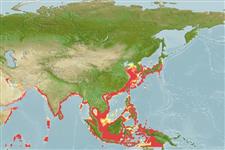Common names from other countries
Environment: milieu / climate zone / depth range / distribution range
Écologie
Pélagique; saumâtre; profondeur 1 - 100 m (Ref. 101307). Tropical, preferred 23°C (Ref. 107945); 41°N - 11°S, 47°E - 142°E
Indo-West Pacific.
Length at first maturity / Taille / Poids / Âge
Maturity: Lm 1.8, range 2 - 1.8 cm Max length : 2.4 cm BL mâle / non sexé; (Ref. 409); 3 cm BL (female)
Phyto- and zooplanktivorous (Ref. 128452). Epipelagic, inhabits shallow coastal waters over muddy bottoms (Refs. 409, 128452). Found in a mangrove vegetate area (Ref. 121475).
Life cycle and mating behavior
Maturité | Reproduction | Frai | Œufs | Fécondité | Larves
Members of the order Decapoda are mostly gonochoric. Mating behavior: Precopulatory courtship ritual is common (through olfactory and tactile cues); usually indirect sperm transfer.
Chan, T.Y. 1998. (Ref. 409)
Statut dans la liste rouge de l'IUCN (Ref. 130435)
statut CITES (Ref. 108899)
Not Evaluated
Not Evaluated
Utilisations par l'homme
Pêcheries: commercial
FAO - Aquaculture: production; pêcheries: landings, species profile | FishSource | Sea Around Us
Outils
Sources Internet
Estimates based on models
Preferred temperature
(Ref.
115969): 20.5 - 29.1, mean 28.2 (based on 1684 cells).
Résilience
Haut, temps minimum de doublement de population inférieur à 15 mois (K=1.3-1.8).
Prior r = 1.19, 95% CL = 0.79 - 1.79, Based on 3 data-limited stock assessments.
Vulnérabilité
Low vulnerability (10 of 100).
